Peştera Veterani
Piskabara - Peştera din Pînza Curii - Veteranische Höhle
Useful Information
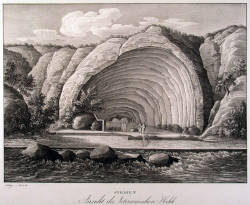
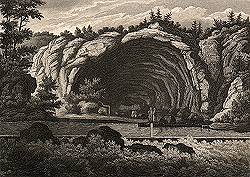
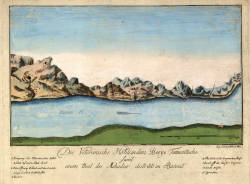
| Location: |
Jetty: Statue of King Decebalus, DN57, Dubova.
(44.599240, 22.262961) |
| Open: |
All year 9-21. Boat ride every 30 min. [2021] |
| Fee: |
Standard:
Adults RON 30, Children (0-7) free. Premier: Group of Four RON 250. Peştera Veterani: Adults RON 6. [2021] |
| Classification: |
 Karst Cave Karst Cave
|
| Light: | n/a |
| Dimension: | A=68 m asl. |
| Guided tours: | boat tours to the cave entrance, D=1h. |
| Photography: | allowed |
| Accessibility: | yes |
| Bibliography: |
(1789):
Geschichte der Veteranischen Höhle,
Mit einem Plan : Ein Beitrag zur Geschichte des Krieges zw. Oestreich u. d. Pforte.
Frankfurt und Leipzig.
Heinz Holzmann, Heinrich Salzer (1989): Die Veterani-Höhle am Eisernen Tor (Rumänien), Zum 200. Jahrestag ihrer Verteidigung gegen die Türken. Die Höhle, 40, pp 11-15. pdf |
| Address: |
Cazanele Dunării, DN57, Dubova, Mehedinți, Tel: +40-744-612-005.
E-mail: English Info: Danube Boilers, Tel: +40-734-94-77-47. E-mail: |
| As far as we know this information was accurate when it was published (see years in brackets), but may have changed since then. Please check rates and details directly with the companies in question if you need more recent info. |
|
History
| 2000 BC | earliest visitors during the Neolithic. |
| ~0 | Roman fortress erected in front of the cave. |
| 1400 | fortress erected by the Austrian Empire. |
| 1692 | cave explored by the imperial captain d’Arnau, fortified and occupied with 300 men. |
| 31-AUG-1788 | defenders of the cave capitulated to the Turkish army. |
| 1891 | cave is a toll station housing 30 soldiers. |
| 1964 | Hydroelectric Power Station project started as a joint-venture between the governments of Romania and Yugoslavia. |
| 1972 | completion of the 10th largest hydroelectric power stations in the world. |
| 2016 | reopened to the public, access by boat. |
Description
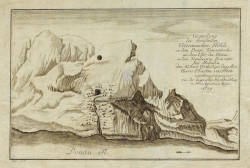
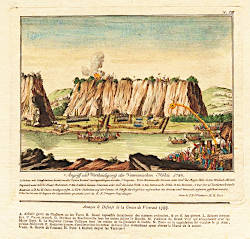

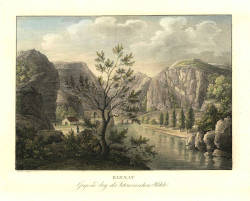
Peştera Veterani (Veterani Cave, Veteranische Höhle) is a show cave which does not exist, we will explain this soon. This part of the Danube is called the Eisernes Tor or Porțile de Fier (Iron Gates) and the river cuts through a karstified limestone ridge forming a canyon with steep walls. It is also called Cazanele Dunării (Danube Narrows, literally Danube Boilers) with the Cazanele Mari (Big Boilers) between the Ciucarul Mare hill (318 m asl) and Ştirbatul Mare hill (768 m asl), and the Cazanele Mici (Small Boilers) between the Dealulele Ciucaru Mic (313 m asl) and the Ştirbatul Mic Hill (626 m asl). In this lower part, the Danube river has an enormous size and the narrows increased the depth to 100 m and the speed of the river to 5 m/s. During the Austro-Hungarian Empire the Danube was the border between Hungary and Serbia, which was occupied by the Turks at that time, and today it is the border between Romania and Serbia. Between 1964 and 1972 the river was dammed by the Iron Gate I dam and the water is used since then in the Hidroelektrana Djerdap (Djerdap Hydroelectric Power Plant) to produce electricity. Actually there are two power stations, each country has its own power station and is allowed to use half of the water. The side effect was the rise of the Danube level by another 60 m and the speed of the water was reduced.
The people realized that there was now a possibility to swim across the border to Yugoslavia, which was open to western tourists and offered access to the Mediterranean. As a result the Romanian government was not happy about Romanians travelling to this border and the area was more or less a restricted area. It was rather hard for western tourists to travel to Romania, but seeing the Iron Gate was impossible. Even scientists were not allowed and given fake information, and in 1989 the famous Austrian cave journal Die Höhle reports that the Veterani Cave was flooded by Danube water. If you think about it, that’s aczually rather strange, because historic engravings show, that the lower entrance was high above the Danube, and there are numerous descriptions from Austro-Hungarian times. So it is quite simple to do the math: the entrance was 60 m above the Danube and after a rise of 60 m it is at the level of the Danube and the cave is not flooded at all. However, the cave was forgotten, and it was not possible to access it without a boat. The Danube was frequented by border patrol ships and there were no private boats allowed. After the end of the Cold War and the collapse of Ceaușescu Regime in Romania, the country was opened and became a member of the European Union. But the cave was still closed. Finally, in the 2010s the area became more popular, hotels opened, numerous operators offered boat rides and water sports, the road DN57 was repaired, and the number of tourists increased. It became obvious that another show cave would generate income, and the cave was restored, a jetty installed, and the reopened cave became a stop on boat tours.
The cave consists more or less only a single chamber with an opening high up in the ceiling. It has trails and is lit by the natural light from outside through the karstfenster. There is a figure of an Austro-Hungarian soldier with an old canon inside, a reminder of the long history of the cave and its importance during the wars against the invading Turks. The cave was manned by up to 1,500 soldiers during the Turkish wars. About 7ß0 soldiers could stay at the cave, the rest manned various batteries around the cave and below the cave along the Danube.
The name of the cave is actually Veteranische Höhle, it was named when this area belonged to the Austro-Hungarian Empire, also known as Danube Monarchy. Friedrich von Veterani, after whom it was named, was from Urbino in Italy. At a very young age he joined the Austrian army and received his Officers’ Patent in 1682, from 1690 he was a General of the cavalry. He defended one of the Danube bridges against the Turkish invasion during the Great Turkish War (1683-1699). In 1691 Veterani succeeded in conquering the fortress of Lippa, his main focus was now entirely on the defence of Transylvania. In 1692, he ordered the imperial captain d’Arnau to explore the cave at the river, which was known until then as Piskabara. He occupied the cave with 300 men and fortified it. At the end of March, the Turkish army began to attack the fortified cave. Initial attacks by Turkish Chaiks - ships with up to 300 crew and 3 cannons - were repulsed. But after a 45-day siege by repeatedly attacking land forces, the imperial garrison was finally forced to surrender to superior forces. Because of this battle, the cave was re-named Veterani Cave.
Veterani continued the defence of Transylvania and in 1694 Kaiser Leopold I. appointed him Feldmarschall (field marshal). In September 1695, the battle of Lugosch took place, where Veterani awaited the attacking Turks with seven regiments of cavalry (about 6,500 men) and 800 men on foot. Veterani lost due to the more than tenfold Turkish superiority. He was seriously wounded, his soldiers tried to remove him from the battlefield, but were caught up and cut down. Veterani was beheaded and his head was handed over to Sultan Mustafa II, who ordered the body to be buried on the spot.
In the course of the Russo-Turkish War (1787-1792), the Veterani Cave was again defended by imperial troops against the Turks. Again the commander, Major Stein, had to bow to the Turkish superiority and capitulated after a tenacious defence on 31 August 1788. The imperial troops were granted free withdrawal.
Veteranische Höhle, in der Temeswarer Gespannschaft in Ober=Ungarn, vier Stunden von Alt=Orsova, am linken Ufer der Donau, im Berge Tamantisches, dessen Umfang sie gleich kommt.
Der Eingang der Höhle ist mit Gesträuchen bedeckt, und hat 2 bis 3 Fuß in der Weite.
Zu oberst am Berge ist eine Oeffnung von ungefähr 8 Fuß im Durchmesser, durch welche einiges Licht hineinfällt.
Die Höhle soll für 1000 bis 1200 Mann Platz haben, und hat ihren Namen von dem Grafen Veterani erhalten, der sie im Jahre 1693 durch einen Officier mit 300 Mann besetzen ließ, die sich nach einer verzweiflungsvollen Gegenwehr an die Türken ergeben mußten.
Ein Gleiches geschah im Jahre 1788, wo der Oberstlieutenant von Stein die Höhle am 31sten August durch Kapitulation, nachdem er sie vom 9ten des gedachten Monats an mit seinen Grenadieren vertheidiget hatte, übergeben mußte, da seine Leute sich kaum mehr auf den Füßen erhalten konnten, und wie Leichen herumkrochen.
Die Kapitulation war ehrenvoll; denn Stein erhielt freien Abzug mit seinen Leuten, und der edle Seraskier, welcher die Türken kommandirte, gab selbst den Degen dem Oberstlieutenant zurück, wobei er befahl, daß seine Leute die kranken und erschöpften Oesterreicher über den Ziegenpfad leiten sollten.
Veterani cave, in the Timisoara County in Upper Hungary, four hours from Old Orsova, on the left bank of the Danube, in the Tamantian Mountain, whose circumference it equals.
The entrance to the cave is covered with bushes and is 2 to 3 feet wide.
At the top of the mountain is an opening about 8 feet in diameter, through which some light falls in.
The cave is said to have room for 1,000 to 1,200 men, and received its name from Count Veterani, who had an officer occupy it in 1693 with 300 men, who had to surrender to the Turks after a desperate resistance.
The same thing happened in 1788, when Lieutenant Colonel von Stein had to surrender the cave on August 31st, after having defended it with his grenadiers from the 9th of that month, as his men could hardly keep on their feet and were crawling around like corpses.
The surrender was honourable; for Stein received free retreat with his men, and the noble Seraskier, who commanded the Turks, himself returned the sword to the lieutenant-colonel, ordering that his men should lead the sick and exhausted Austrians over the goat path.
D. Johann Georg Krünitz (*1773-✝1858):
Oekonomische Encyklopädie, oder allgemeines System der Staats- Stadt- Haus- und Landwirthschaft.
online
The oldest human remains discovered in the Veterani Cave are 4,000 BP from the late Neolithic. Fossils of cave bear (Ursus spelaeus) and cave hyena, also several endemic species were found. The cave is a central location in the famous Ayla series by Jean M. Auel, a historical fiction about life in the Neolithic written by an archaeologist. Later the cave became a temple for the Dacians, who worshiped the god Zamolxis. They sacrificed birds on an altar, the bones were found during excavations. Romans built a small fortress in front of the cave 2,000 years ago, a fortress which lasted more than 1,000 years. In 1400, the area was now part of the Austro-Hungarian Empire, they erected the first fortification at the cave. This destroyed most of the Roman remains. Later, during the Turkish Wars, much of the cave was remodelled and a lot of archaeological remains destroyed, so our knowledge of the early history of the cave are rather fragmentary.
There were also legends about the cave, about the legendary treasures of Maria Theresa or in other versions of the Serbian tsar Obrenovici. And as always, no matter how stupid such a legend is there are always treasure hunters. Numerous ditches in the main hall are attributed to those treasure hunters. And they even created new legends. On the cave walls is written in red letters, the word "KAROL - 1992". At the entrance to the Small Boilers, you can see the remains of a car, but only when the waters of the Danube are low. Karol was one of the treasure hunters, and he came to the cave in 1992 to search for the treasure. He returned in 1994 to continue digging, but for reasons still unknown, his car plunged into the river. He then emigrated to Australia, where the search for treasures was probably less dangerous. At least that’s how the urban legend goes. There is also a legend that the cave was used to store ammunition and food between the wars, but we have actually no idea for what reason. Probably smuggling.
The boat ride along the Danube canyon offers various sights, and the Peştera Veterani is only one of them. The sights are Decebal’s face, Dubova Bay, Ponicova Cave, Veterani Cave, Great Boilers, Small Boilers, and Mraconia Bay. Nearby Ponicova Cave is flooded at the lower end and boats enter the first few meters into the cave. If you want to visit this semi wild cave you have to walk to the other entrance of the through cave and do the tour from the other side. Peştera Veterani does not have a second entrance, and can only be visited during the boat ride. The boats land at a small jetty and the participants can visit the cave. There is an additional fee for the cave visit.
 Search DuckDuckGo for "Peştera Veterani"
Search DuckDuckGo for "Peştera Veterani" Google Earth Placemark
Google Earth Placemark Friedrich von Veterani
Friedrich von Veterani  (visited: 14-AUG-2021)
(visited: 14-AUG-2021) Cazanele Dunării boat rides (visited: 14-AUG-2021)
Cazanele Dunării boat rides (visited: 14-AUG-2021) Index
Index Topics
Topics Hierarchical
Hierarchical Countries
Countries Maps
Maps